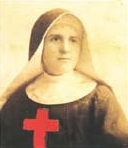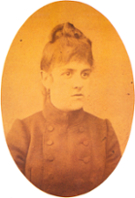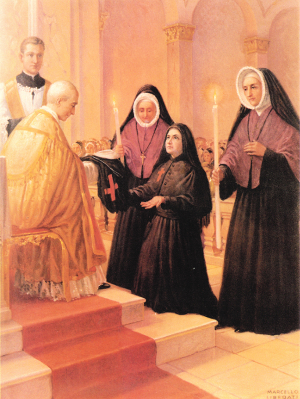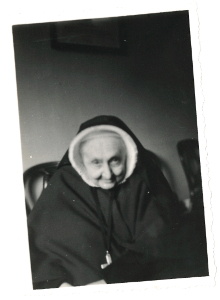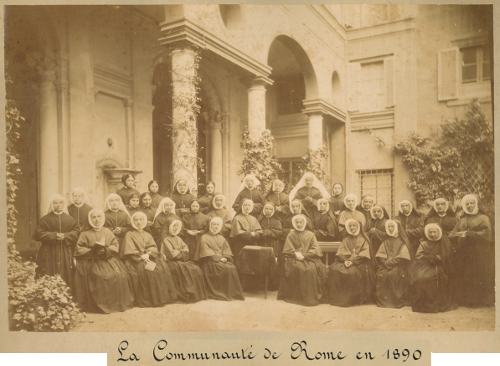Submitted by Wandrille on
On the occasion of the canonization of Giuseppa Vannini, Co-founder of the Daughters of St. Camillus of Lellis, October 13, 2019 in Rome, we share with you the translation of an article published in June 1967, in the French publication Au Cenacle to which we added illustrations.It would seem that it is the charism of the Cenacle to be, to varying degrees, the cradle of new groups... because it was from the Cenacle of Jerusalem that the Apostles and the first disciples, illuminated and fortified by the Holy Spirit, left to work for the spreading of the Kingdom of God… The story of Giuditta Vannini is characteristic: it is precisely in the Cenacle of Rome (via della Stamperia) that she found the light of her vocation that had been long and painfully sought after. |
|
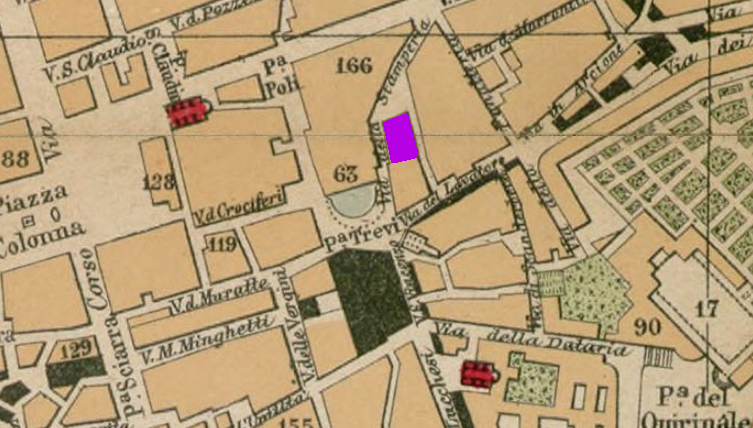
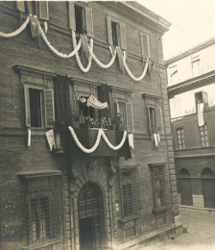
On the left, in purple, location at the time of the Roman Cenacle, next to the Trevi Fountain. On the right, entrance of the house decorated for a Feast at the beginning of the 20th century.
|
It was December 1891. Our Mothers had organized a retreat for French-speaking women and girls. The priest who was supposed to come and preach it was replaced at the last minute by Rd. Fr. Tezza, of the Order of St. Camillus, Ministers to the Sick, confrère of Fr. Ferrini, confessor of the Community – two equally distinguished religious. So far, this was nothing unusual in the life of the Cenacle.... However, let us look at the "paths" of Providence... A few days earlier, Fr. Mondini, a Vincentian priest, had given to one of his spiritual daughters, Miss Vannini – 31 years old – an invitation to this retreat. "Here, this is the invitation card I just received from the Superior of the Ladies of the Cenacle. There will be a retreat these days; take the opportunity. We will meet again and decide something when I get back... " |
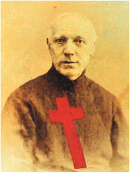 |
Father Gioacchino Ferrini. He had previously been Superior General of the Camillians (1884-1889) |
|
|
Giuditta Vannini in December 1891 |
Who was Giuditta Vannini? – An orphan from a comfortable merchant background, born in Rome on July 7, 1859, then entrusted to one of her aunts. When her double misfortune reached her, she was only 7 years old. Separated from her older sister and her younger brother, she was placed in the Orphanage of the Daughters of Charity and she received instruction there. It seems that she felt the call for a total donation of herself on the day of her first Communion. She was then 13 years old. It was a delicate soul that the Lord led through the Royal Way of the Cross. Gentle and reserved, suffering from severe headaches that did not alter her steady mood, she silently endured the malicious and prolonged teasing of a thoughtless companion. |
At the age of 24, three years after having left the Orphanage, Guiditta applied for admission to the Sisters of St. Vincent de Paul, stayed there for seven years and was sent back to the world twice, for unknown reasons, which only an orderly design from Above can explain.
In order to escape the earthly demands of which her brother, in all Christian honesty, was the champion, she settled in with the Sacramentines Sisters. However, they were aware of the treasure they had acquired, so they insisted that Miss Vannini enter their congregation. Cutting short the proceedings, Giuditta obtained a position in Portici, in an establishment of the Daughters of Charity, with whom she had remained on good terms.
There again, the turn of fate pursued her; because certain conflicts threatened the peace of the house, she definitively returned to her aunt’s, upset, confused, but always certain of God's call.
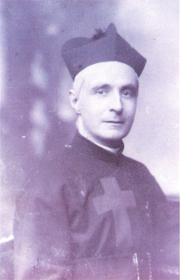 |
Father Luigi Tezza (1841-1923) at the age of about 40 years old |
It was then that the invitation to the retreat voluntary preached by Fr. Tezza reached her. Who was this Reverend Father himself? The Procurator of the Camillians, to whom, ten months earlier, his General Chapter had entrusted the task of reconstituting the Third Order Regular of the Sisters, once flourishing in Italy and France, but that times had scattered or reduced to inexorably diocesan branches. Lille, where there were priests, offered a house through Mesdemoiselles Legrand, but Father Tezza, as Procurator, could not leave Rome. It was there that, for months, he had been searching in vain for an outcome to the project. Now, at the very first evening of the retreat, Miss Vannini, more anxious than ever, asked him for an interview in the confessional and told the painful story of her vocation... Father Tezza, attentive and compassionate, proposed various Institutes; but as nothing seemed to satisfy the penitent, he ended asking, half serious, half amused: "Come on, would you want to be a Foundress?" |
The young woman, mortified, remained silent.... Foundress! she had certainly never thought of it.... However, a ray from Above had just struck the confessor: was it not the first stone of the work, which God sent to him?[1]
Peacefully, the priest outlined his plan. Giuditta listened to him "without objections or enthusiasm," the chronicle reports. When he had finished, she replied: "Let me think, Father, I will give you a definitive answer." As a discerning young woman, she wanted to submit the matter to her Vincentian Director. And it was only when "St. Vincent's agreement with St. Camillus was assured" - the day after the closing - that she declared in a few words to Father Tezza that she would be totally at his disposal.
|
Thus, according to Fr. Mondini's remark, childlike submission and perfect abandonment were the result of the hard years of trial....
Five years later, recalling the providential encounter, Mother Vannini confided the following in a tiny note: "On December 17, I had the good fortune to know R.P. Tezza. I explained to him the feelings of my soul and he, as a Father, advised me, comforted me and opened to me the way of the Lord, in which I now find myself happy and content (felice e contenta). It is to him, after God, that I owe gratitude and filial affection. » Soon, two young women joined Miss Vannini and the trio struggled to find a place to start the work, under the direction of the Founder. The Cenacle where the Holy Spirit had manifested himself so well remained a little like a family home; our Mothers would even have contributed to the first formation. And when the time came for Giuditta - now Sister Giuseppa – to put on the livery of the Lord, some Cenacle Sisters sewed portions of her religious habit. In addition, our house was chosen to host the ceremony, which was to be strictly private and secret. It therefore took place in the "cappelleta" of the retreatants, an oratory with thick walls and rare light, located on the ground floor of the old palace, and leading, on one side, to the courtyard, on the other, to the famous "salita", a wide spiral ascent, which served as stairs. This small chapel resembled Bethlehem enough to be a cradle!.... A tiny tribune, with an equally small harmonium, opened at the height of the first floor of the slope. Mother Rey used it to beautify the celebration. We do not know the program of the songs, but the witnesses remembered that, under the fingers of this authentic artist, the small instrument contributed, with the lights and flowers, to make the oratory a vestibule of Paradise... Mother Vannini had been in the Cenacle since the day before, immersed in recollection. Only five postulants and some of our sisters attended Mass, celebrated by Fr. Tezza who first blessed and imposed the Holy Habit. According to custom, and as suggested in a painting, Mother Isabelle de Montgrand, Superior, had to accompany the blessed Novice to the altar. It was Saturday, March 19, 1892, three months after the providential meeting. The Benediction of the Blessed Sacrament ended the service. |
Mother Isabelle de Montgrand (1852-1935) two months before her death. She was the Superior and the Novice Director of the Roman Cenacle from 1881 to 1894. |
| The Cenacle Sisters were in Rome only since the end of 1879, but their ministry was quickly developing. See the photograph of the community at the time:
|
We don't have a photograph of the small chapel on the ground floor where Giudittta Vannini's Clothing Ceremony took place. It was at the end of the cloister, on the left. However, we have photographs of the large chapel on the first floor. Perhaps that's where Father Tezza preached.
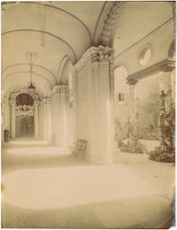 |
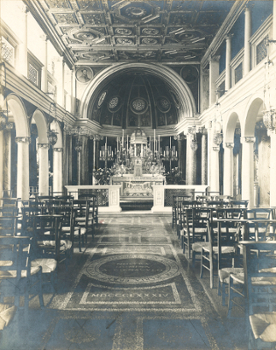 |
Mother Giuseppina Vannini with her first two companions (1892) |
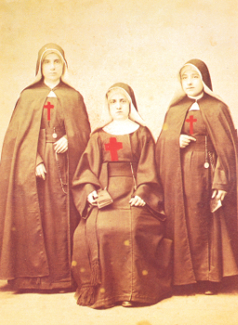 |
The Daughters of St. Camillus then flourished in a divine way, that is, in the midst of tribulations from which the life of the Founders was never weaned... But what does it matter! when you are finally sure that you have found the divine Will, and that you follow it...
When Mother Vannini was called to God on February 25, 1910, her Congregation was already spreading far and wide. Crossing the Italian border, it flourished particularly in Argentina, where the mortal remains of the venerated Fr. Tezza were transferred from Lima, surrounded by the prayers of the Community and the Novitiate. The Investigation process into the heroism of the virtues of the Foundress opened in Italy; graces were obtained. The Daughters of St. Camillus do a great deal of good in hospitals, to the sick, the poor, the children.
|
A sisterly affection always unites them with the Cenacle.
Guyonne de LORGERIL, r.c.
[Translation 2019]

